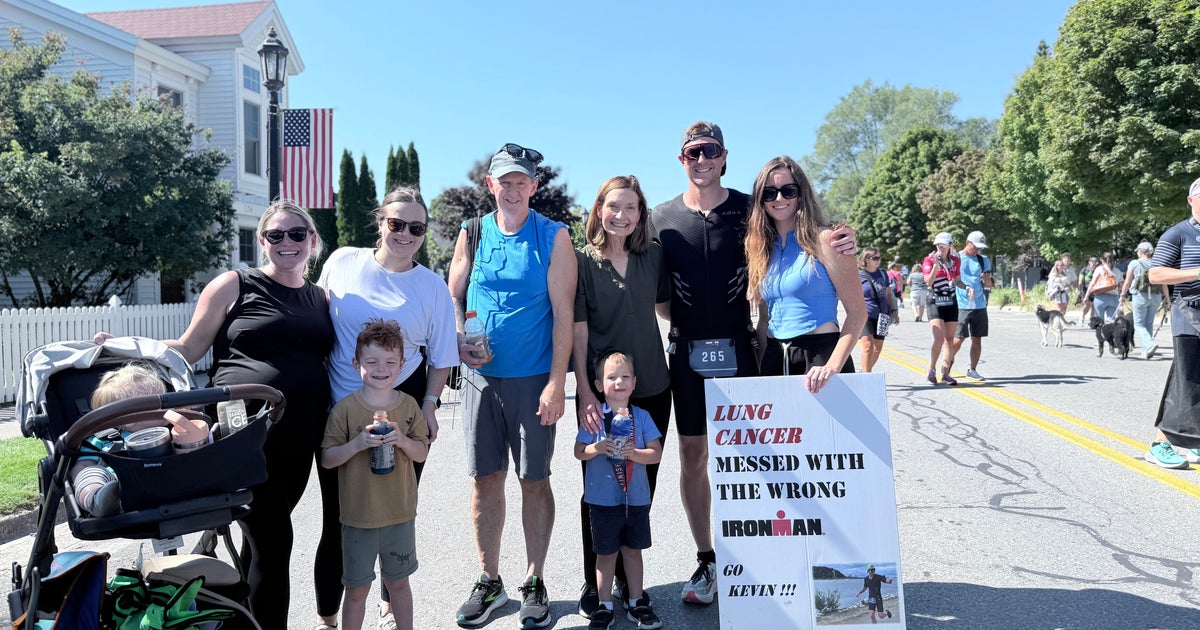Endurance athlete Kevin Humphrey was used to discomfort. He regularly participated in ultramarathons and other intense events. Swimming, biking and running dozens of miles at a time was standard for him. His two young sons also kept him active even when he wasn’t training. But in January 2024, a persistent back pain kept bothering him.
The pain “just would not go away,” Humphrey said. He couldn’t sleep on his back. At the same time, he started coughing. He was diagnosed with pneumonia, but his symptoms lingered even after treatment. A chest CT scan found “something going on” in his left lung. A biopsy of the organ came back inconclusive, Humphrey said, but he kept pushing for answers.
“I knew something was off. It just didn’t feel right,” Humphrey said.
Humphrey traveled from Michigan to Chicago to seek a second opinion at Northwestern Medicine in May 2024. A bronchoscopy found shocking results: There was a tumor in his lung that was crushing the left side of his windpipe, causing the coughing and pain.
“I was really in disbelief,” said Humphrey, who had never smoked and had no family history of lung cancer. “It wasn’t even on my radar as a possibility. It wasn’t even an option in my mind.”

Kevin Humphrey.
Kevin Humphrey
“A very concerning and dire situation”
Humphrey was diagnosed with Stage IV non-small cell adenocarcinoma, joining the growing number of young, non-smoking patients diagnosed with lung cancer. The rise may be driven by environmental or lifestyle factors, Dr. Jonathan Villena-Vargas, a thoracic surgeon at NewYork-Presbyterian and Weill Cornell Medicine, previously told CBS News. Villena-Vargas, who did not treat Humphrey, said there is no definitive reason for the increase.
Further tests found that the cancer had spread beyond Humphrey’s lung and had likely been growing for at least a year, Humphrey said. The disease typically has a 37% 5-year survival rate at that point, according to the Cleveland Clinic.
Humphrey’s tumor was “pretty advanced” and too large for surgery at first, said Dr. Daniel Dammrich, the Northwestern Medicine oncologist who treated him. But doctors were able to identify a “driver mutation” that was encouraging the cancer’s growth. These mutations are more common in young, non-smoking patients, Villena-Vargas said.
Identifying the mutation “really opened the door for some of our more nuanced, targeted therapies,” Dammrich said, and “turned a very concerning and dire situation into a much more optimistic one.”
Dammrich and Humphrey agreed on an aggressive plan that would combine targeted immunotherapy with chemotherapy, in the hopes that the medications would shrink the tumor enough for surgery. Humphrey began immunotherapy immediately, then had chemotherapy in summer 2024. By August, the cancer was operable.

Kevin Humphrey receives chemotherapy at Northwestern Medicine.
Kevin Humphrey
“The biggest question mark”
Removing the cancer meant taking out about half of Humphrey’s left lung. The athlete wasn’t sure what that would mean for his passion.
“You just had no idea. Can you run again, can you bike, can you do all these endurance sports that I’ve loved doing?” Humphrey said. “That was the biggest question mark going into surgery.”
Despite the unknowns, he focused on the future. Michigan’s Ironman 70.3 race — which included a 1-mile swim, 56.1-mile bike ride and a 13.2 mile run — was scheduled to take place a year and a day after his surgery. Humphrey decided to sign up, despite his fears.

Kevin Humphrey in the hospital.
Kevin Humphrey
Humphrey had surgery in mid-September. The operation removed most of the cancer, Dammrich said. Recovery was its own battle. Broken ribs and a “pretty big” incision made it difficult for Humphrey to do simple tasks like get out of bed or walk more than a few steps. Running was out of the question for months. But he kept putting one foot in front of the other until his strength and endurance began to slowly return. Even on the hardest days, the upcoming race kept him motivated.
“It was a great mental thing to put on the calendar and train for,” Humphrey said.
“Across the finish line”
On Sept. 14, Humphrey was one of over 1,600 athletes who took part in the Ironman. He finished in just under five and a half hours, coming in 411th place. The race was exhausting and emotional, Humphrey said.
“You’re replaying everything that’s happened over the past year and the whirlwind it’s been,” Humphrey said. “For me, when I got to the point of knowing ‘I’m going to finish this race’ and thinking about my young boys, my wife, the family and the community and support system we’ve had throughout the whole year, and how grateful I am to not only be here but to continue to do these types of races and events. I certainly did not think that was going to be the case when I received the diagnosis in May of ’24.”

Kevin Humphrey’s son gives him a high-five during the Ironman 70.3 Michigan.
Kevin Humphrey
Humphrey’s medical situation is also positive. He had a complete response to the treatment, and there is currently no evidence of disease in his body, Dammrich said. Regular CT scans and blood tests watch for any new tumor growth. Humphrey remains on immunotherapy with few side effects.
On Oct. 12, less than a month after the Ironman, Humphrey ran the Chicago marathon for the sixth time. Over 53,000 runners participated in the race. Humphrey placed 25,395th, finishing in about seven and a half hours. It was “40 or 45 minutes slower” than when he ran the same race in 2023, Humphrey said, but he was proud to have finished.
“My goal was just to get across the finish line, and that’s what we did,” Humphrey said. “I was just grateful for the ability to be out there and to run and be doing the things that I’ve loved doing for such a long time.”

Kevin Humphrey’s sons cheer him on during the Chicago marathon.
Kevin Humphrey
More from CBS News
